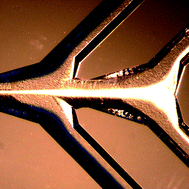Decomplexing biofluids using microchip based acoustophoresis
Abstract
Highly efficient washing and

* Corresponding authors
a
Department of Electrical Measurements, Division of Nanobiotechnology, Lund University, P.O. Box 118, Lund, Sweden
E-mail:
per.augustsson@elmat.lth.se
Fax: +46 46 2224527
Tel: +46 46 2229786
b Department of Immunotechnology, Lund University, Biomedical Centre D13, Lund, Sweden
Highly efficient washing and

 Please wait while we load your content...
Something went wrong. Try again?
Please wait while we load your content...
Something went wrong. Try again?
P. Augustsson, J. Persson, S. Ekström, M. Ohlin and T. Laurell, Lab Chip, 2009, 9, 810 DOI: 10.1039/B811027A
To request permission to reproduce material from this article, please go to the Copyright Clearance Center request page.
If you are an author contributing to an RSC publication, you do not need to request permission provided correct acknowledgement is given.
If you are the author of this article, you do not need to request permission to reproduce figures and diagrams provided correct acknowledgement is given. If you want to reproduce the whole article in a third-party publication (excluding your thesis/dissertation for which permission is not required) please go to the Copyright Clearance Center request page.
Read more about how to correctly acknowledge RSC content.
 Fetching data from CrossRef.
Fetching data from CrossRef.
This may take some time to load.
Loading related content
